
HOME
INTRO
SYMBOLS
ALMANAC
ECONOMY
GEOGRAPHY
STATE MAPS
PEOPLE
FORUM
NEWS
COOL SCHOOLS
STATE QUIZ
STATE LINKS
BOOK STORE
MARKETPLACE
NETSTATE.STORE
NETSTATE.MALL
GUESTBOOK
CONTACT US


South Carolina State Insect
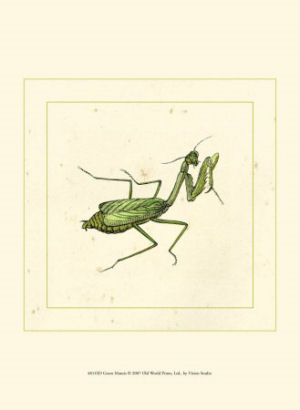
South Carolina State Insect: Carolina mantid or praying mantis
Photographs, posters, prints
South Carolina Law
The following information was excerpted from the The South Carolina Code of Laws, Title 1, Chapter , Article 9, section 1-1-645.
Title 1 - Administration of the Government
CHAPTER 1. GENERAL PROVISIONS
ARTICLE 9. STATE EMBLEMS, PLEDGE TO STATE FLAG, OFFICIAL OBSERVANCES
SECTION 1-1-645.
SECTION 1-1-645. Official State insect.
(A) The Carolina mantid, Stagmomantis carolina (Johannson) , or praying mantis, is the official insect of the State.
(B) A statement in substantially the following form must be printed in the next edition and all subsequent editions of the South Carolina Legislative Manual in the appropriate section:
The State Insect
The Carolina mantid, Stagmomantis carolina (Johannson), or praying mantis, was designated the state insect by the General Assembly by Act 591 of 1988, for the following reasons: it is a native, beneficial insect that is easily recognizable throughout the State; it symbolizes the importance of the natural science of entomology and its special role in all forms of agriculture in helping to control harmful insects; and it provides a perfect specimen of living science for the school children of this State.
Sources...
State of South Carolina. South Carolina Code of Laws. Columbia: State of South Carolina, 2011. Web. 28 May 2011. .
Shearer, Benjamin F. and Barbara S. State Names, Seals, Flags and Symbols: A Historical Guide Third Edition, Revised and Expanded. Westport, Conn: Greenwood Press, 3 Sub edition, 2001.
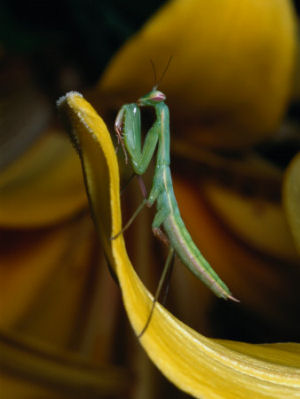
South Carolina State Insect: Carolina mantid or praying mantis
Photographs, posters, prints
Additional Information
Praying Mantids: University of Kentucky: College of Agriculture.
Stagmomantis carolina Carolina Mantis: Bugguide, hosted by Iowa State University Entomology.
Stagmomantis carolina (Carolina mantid): The University of Michigan Museum of Zoology: Animal Diversity Web.
Stagmomantis carolina - (Johannson), Praying Mantis : A network connecting science with conservation - NatureServe Explorer: An Online Encyclopedia of Life.
Stagmomantis carolina (Johannson, 1763) : Integrated Taxonomic Information System (ITIS) Here you will find authoritative taxonomic information on plants, animals, fungi, and microbes of North America and the world.
State Insects: Complete list of official state insects from NETSTATE.COM.
More symbols & emblems: Complete list of official South Carolina state symbols from NETSTATE.COM.

Mantids and
their Relatives
Elaine Pascoe
Mantids and their Relatives (Nature Close-Up), by Elaine Pascoe. 48 pages. Publisher: Blackbirch Press; 1st edition (December 8, 2004) Reading level: Ages 9-12. With their alien appearance and odd ways, mantids are fascinating to watch. Learn how these insects catch their prey and follow their life cycle from egg to adult. Experiments and activities provide a chance to watch mantids up close and gain deeper understanding of their ways.
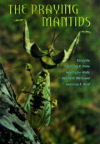
The Praying Mantids
The Praying Mantids, edited by Frederick R. Prete, Harrington Wells, Patrick H. Wells, and Lawrence E. Hurd. 400 pages. Publisher: The Johns Hopkins University Press; 1 edition (November 24, 1999) Praying mantids have fascinated people for thousands of years. In their Book of the Dead, ancient Egyptians honored the mantis as a minor deity, the "Bird-Fly," whose function was to conduct the souls of the dead to the netherworld. The Chinese bred mantids for fighting and celebrated their ferocity and foolhardy courage (they sometimes attack prey larger than themselves) in songs and poems.
The Praying Mantids represents the current state of knowledge on these remarkable insects, bringing together all that is currently understood about their ecology, taxonomy, reproduction, sensory systems, motor behavior, and defense strategies.
Generously illustrated and admirably comprehensive, The Praying Mantids is an invaluable resource for researchers, students, and teachers in the life sciences, as well as a fascinating book for hobbyists and anyone interested in animal behavior and natural history.
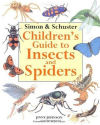
Children's Guide to
Insects and Spiders
Jinny Johnson
Simon & Schuster Children's Guide to Insects and Spiders , by Jinny Johnson. 64 pages. Simon & Schuster Children's Publishing (May 1, 1997) Reading level: Ages 4-8. A detailed introduction to spiders and insects contains information about every major group of arachnids and insects, hundreds of thought-provoking facts, and full-color pictures and photographs."
Eyewitness Workbooks: Insect, 48 pages. DK CHILDREN; Workbook edition (June 16, 2008) Reading level: Ages 4-8. Perfect for getting ahead at school or just stimulating children's interest, this groundbreaking series of workbooks leaves the competition in the dust, with exciting subjects, 48 full-color pages, a turn-and-learn info wheel, and special carrying folders. This book helps kids take their knowledge of insects to the next level, from battling beetles to buzzing honeybees.

Garden Insects of North America
by Whitney Cranshaw
Garden Insects of North America: The Ultimate Guide to Backyard Bugs, by Whitney Cranshaw. 672 pages. Princeton University Press (March 8, 2004) Garden Insects of North America is the most comprehensive and user-friendly guide to the common insects and mites affecting yard and garden plants in North America. In a manner no previous book has come close to achieving, through full-color photos and concise, clear, scientifically accurate text, it describes the vast majority of species associated with shade trees and shrubs, turfgrass, flowers and ornamental plants, vegetables, and fruits--1,420 of them, including crickets, katydids, fruit flies, mealybugs, moths, maggots, borers, aphids, ants, bees, and many, many more.
Smithsonian Handbooks: Insects, by George C. McGavin. 256 pages. DK ADULT; 1st edition (October 1, 2002) Packed with over 650 crystal--clear photographs and illustrations with precise annotation to make identification sure and simple. Authoritative text, crystal--clear photography, and a systematic approach make this handbook the most comprehensive recognition guide to the insects, spiders, and other terrestrial arthropods of the world.
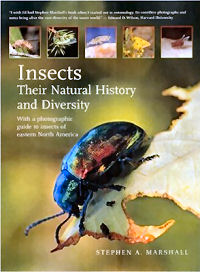
Insects by Stephen A. Marshall
Kaufman Field Guide to Insects of North America, by Eric R. Eaton, Kenn Kaufman. 392 pages. Houghton Mifflin Harcourt; 1 edition (February 28, 2007) In the new Kaufman Field Guide to Insects of North America, readers will find a wealth of information on the amazing observable behaviors of insects and their fascinating life histories. Naturalists Kenn Kaufman and Eric R. Eaton use a broad ecological approach rather than overly technical terms, making the book accessible and understandable for everyone. The guide is lavishly illustrated, with more than 2,350 digitally enhanced photographs representing every major group of insects found in North America north of Mexico.
National Wildlife Federation Field Guide to Insects and Spiders & Related Species of North America, by Arthur V. Evans. 496 pages. Sterling (May 31, 2007) National Wildlife Federation's new all-photographic field guide to North American insects, spiders, and related species, is the most up-to-date of its kind, and lets both amateur and expert naturalists identify more than 940 species quickly and accurately. More than 2,000 close-up color photographs by leading nature photographers reveal the field marks that distinguish each creature, and the clear and concise text that accompanies each image describes the range, habitat, life cycle, and behavior.
Insects: Their Natural History and Diversity, by Stephen A. Marshall. 736 pages. Firefly Books; Updated edition (June 2006) Meticulously researched and illustrated with color photographs, Insects is a landmark reference book that is ideal for any naturalist or entomologist. To enhance exact identification of insects, the photographs in this encyclopedic reference were taken in the field -- and are not pinned specimens.

